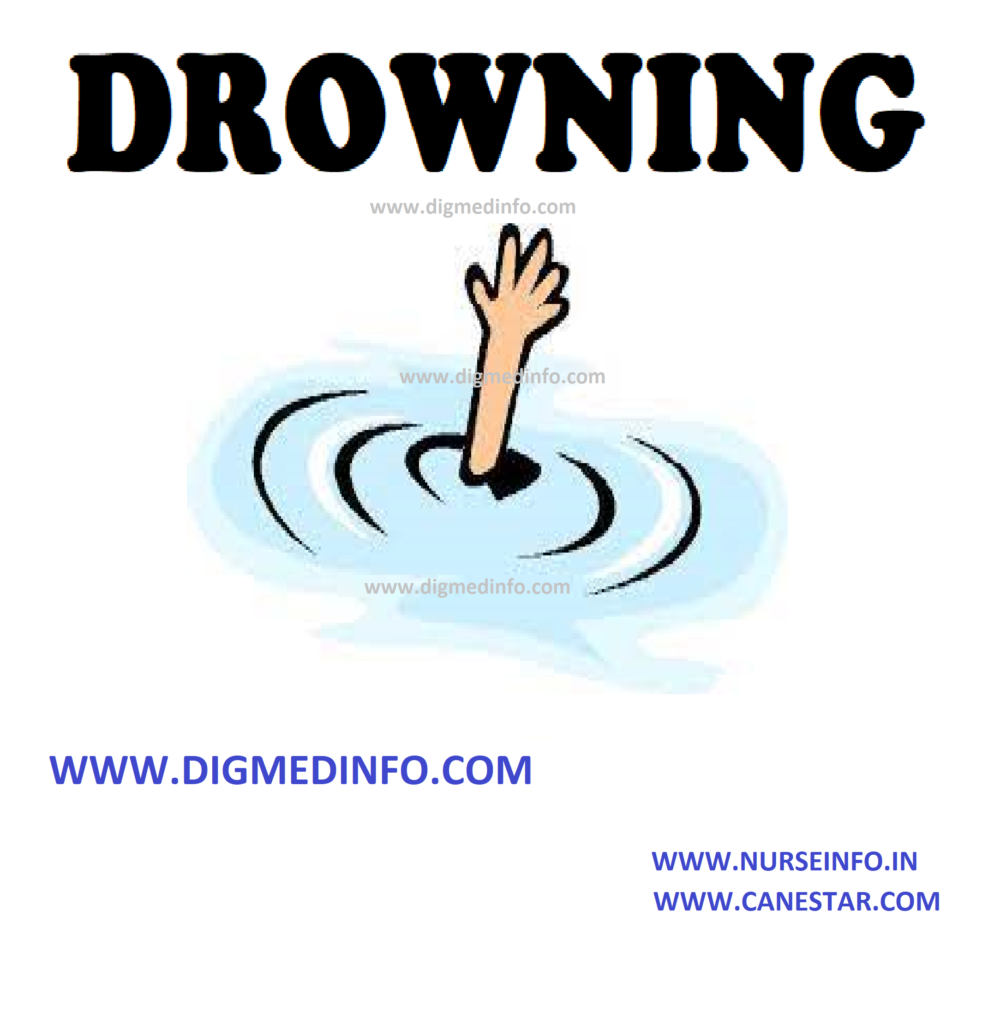DROWNING – General Considerations, Pathology and Clinical Features, Management, Prognosis and Prevention
GENERAL CONSIDERATIONS
Definition:
Drowning is the pathological state leading to death resulting from the aspiration of water into the respiratory tract or due to asphyxia immersion. More than 2 lakh persons die annually of drowning, 25% in sea and 75% in inland waters. Two types of drowning have been recognized – dry drowning and wet drowning. In dry drowning death is due to laryngeal spasm, which proves fatal in 20% of the subjects. This also prevents the entry of water into the lungs.
In wet drowning water enters the lungs. The consequences differ between fresh water and sea water drowning. In fresh water drowning, water is quickly absorbed from the lungs, leading to hemodilution and hemolysis with release of potassium from the red blood cells. In addition to hypoxia and ventilatory failure, hyperkalemia precipitates ventricular arrhythmias, which may prove fatal.
In salt water drowning the fluid in the lung is hyperosmotic. It absorbs more fluid into the alveoli causing pulmonary edema and respiratory failure. Hypernatremia follows later when the salt is absorbed into the circulation. In addition to the metabolic and local effects, impurities and contaminants give rise to local infection.
Secondary Drowning or near-drowning occurs a few hours or few days after the initial resuscitation due to the secondary changes in the lungs such as pulmonary edema, pneumonia, pneumothorax, electrolyte disturbances and metabolic or respiratory acidosis. This accounts for 25% of deaths.
Immersion syndrome
In this, sudden death occurs due to cardiac arrest caused by vagal stimulation brought about by sudden immersion into cold water.
PATHOLOGY AND CLINICAL FEATURES
Lungs: Pulmonary edema develops. Fresh water interferes with surfactant leading to formation of hyaline membrane, atelectasis and hypoxemia. Aspiration of foreign particles worsens the atelectasis. Bacterial infection leads to pneumonia or lung abscess.
Heart: Arrhythmias such as ventricular fibrillation and cardiac arrest may occur. Electrocardiogram may show nonspecific changes due to asphyxia.
Kidneys: Acute tubular necrosis may develop in neardrowning in fresh water due to hemolysis and prolonged hypotension.
Central nervous system: Asphyxia leads to loss of consciousness, cerebral edema and convulsions. Sequelae of anoxic encephalopathy such as transient hemiparesis, quadriparesis, choreoathetosis, aphasia and faciobrachial weakness may develop.
MANAGEMENT
First aid: (1) clear the airway of water and foreign bodies by putting the patient head low and by suction, (2) institute mouth-to-mouth breathing as early as possible, (3) closed chest cardiac massage should be instituted if heart sounds are absent, and (4) all cases must be hospitalized to prevent death from secondary drowning.
Hospital treatment: This aims at (1) maintenance of adequate oxygenation, (2) correction of metabolic and electrolyte imbalance and (3) prevention of secondary effects. Adequate oxygenation is achieved by the use of controlled ventilation with 100% oxygen, later to be reduced to 40%. If these measures fail to respond intubation and application of positive and expiratory pressure (PEEP) respiration should be resorted to. The PEEP increases the functional residual capacity, thereby minimizing intrapulmonary shunts and ventilation perfusion abnormalities, and promotes better oxygenation. If bronchospasm is present, an aerosoal of salbutamol 200 mcg should be administered. Acidosis is to be corrected with sodium bicarbonate given intravenously in a dose of 0.7 to 1 mmol/kg bw. Proper correction of electrolyte imbalance and acidosis should be monitored with laboratory estimations.
Constant observation and appropriate management of pulmonary edema, pneumonia and pneumothorax serves to prevent secondary drowning. Prophylactic antibiotics have to be used to prevent respiratory infections. Skiagram of the chest is necessary in all cases to detect complications. Atelectasis has to be managed with bronchoscopic aspiration. In severe cases of pulmonary edema, dexamethasone given in a dose of 0.5-1 mg/kg bw in 24 hours IM or IV has been successful. If signs of intracranial hypertension develop, it is treated with hyperventilation and IV infusion of 200 mL of 20% mannitol.
Prognosis
This depends on the extent and duration of hypoxia and the first aid. Patients presenting with coma and cardiac irregularities have higher mortality and morbidity.
Immersion in cold water causes death earlier due to rapid cooling, but survivors show less tendency to develop neurological sequelae. Residual complications of near drowning include convulsive disorders, intellectual impairment, cardiac neurosis and pulmonary atelectasis leading to bronchiectasis.
Prevention:
Education of the public on the hazards in water and first aid measures to save drowning victims should be available in places of water sports, holiday resorts and beaches. Trained lifeguards should be available at public swimming places.


